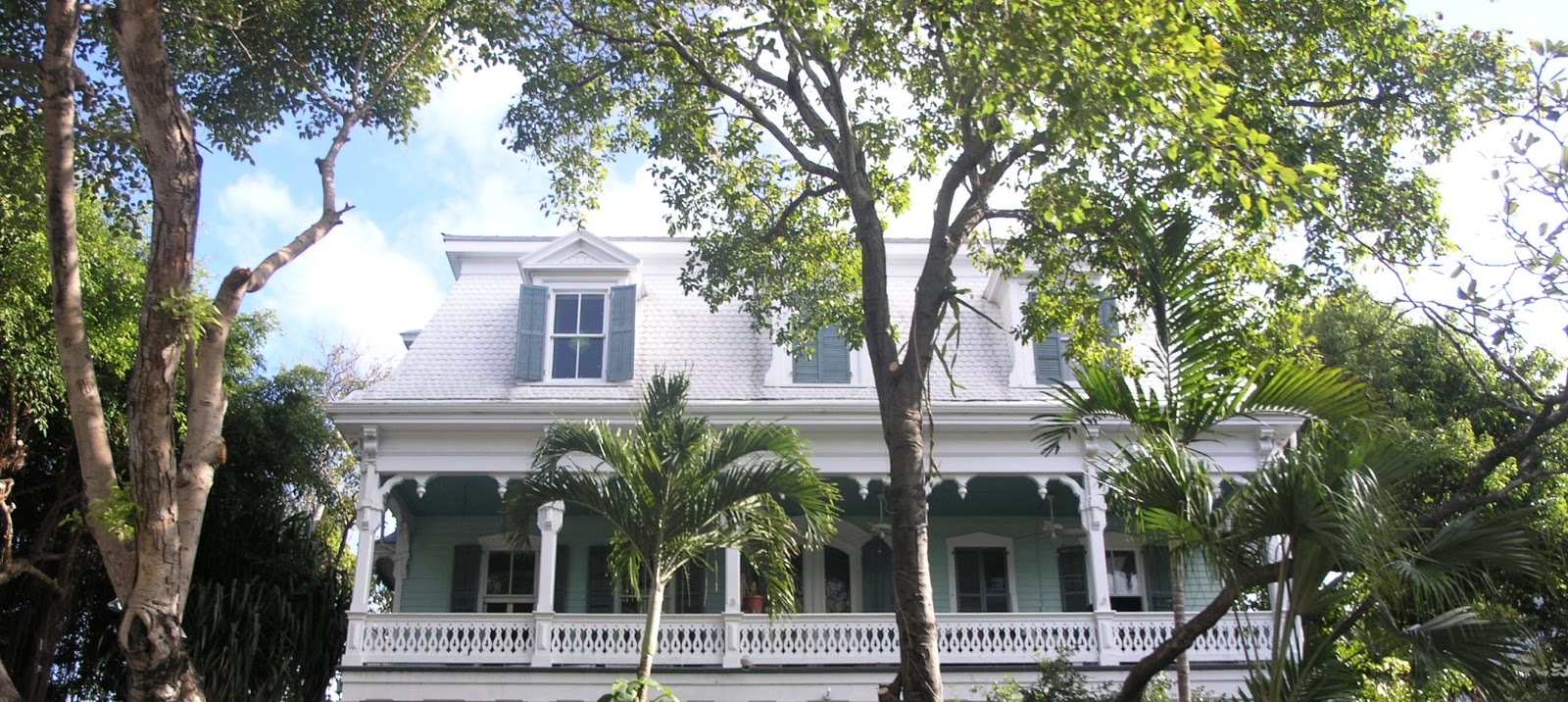We awoke to the sunshine and 80 degree temperature of Key
West. While breakfasting we once again
charted our day together and consensus was to head to the southernmost tip of
Key West and work our way back up Duval Street.
 After parking on Whitehead Street in front of the Post
Office, we strolled the Truman Annex district. Within its premiere neighborhood
we walked around the Little White House, was originally waterfront when it was
built in 1890 as the first officer's quarters on the naval station, and was
then converted to house the base commandant twenty years later. The residents
lost their waterfront views when the base built more buildings on its shores.
After parking on Whitehead Street in front of the Post
Office, we strolled the Truman Annex district. Within its premiere neighborhood
we walked around the Little White House, was originally waterfront when it was
built in 1890 as the first officer's quarters on the naval station, and was
then converted to house the base commandant twenty years later. The residents
lost their waterfront views when the base built more buildings on its shores. Truman was not the only to stay in this home. Others
included Eisenhower, JFK, and Thomas Edison. This two-story white-clapboard
home is quite simple in its appearance and resembles a northeast lakeside
cottage. Restoration to its original 1949 appearance continues today and is a
state historic site & museum.
Truman was not the only to stay in this home. Others
included Eisenhower, JFK, and Thomas Edison. This two-story white-clapboard
home is quite simple in its appearance and resembles a northeast lakeside
cottage. Restoration to its original 1949 appearance continues today and is a
state historic site & museum.
We returned to the Conch Train near Mallory Square to take
advantage of our two-day pass and debarked a few blocks from the southern buoy.
Cameras were focused and clicked as we stood by the landmark
which indicates the southernmost point of Florida. The brightly painted
concrete buoy is one of the most visited and photographed attractions in Key
West. The experience was enhanced when we dodged the waves cresting the retaining
wall and the salty breezes re-arranged
our hairstyles.
 We then began our Duval Crawl, albeit zigzagging along a few
side-streets to see the Key West Lighthouse, Hemingway’s home, the Butterfly
Conservatory and a few shops to shop. Along the way we stopped to peer between wrought
iron fences at some stately homes, and walked past “shotgun” houses and “conch style” homes.
We then began our Duval Crawl, albeit zigzagging along a few
side-streets to see the Key West Lighthouse, Hemingway’s home, the Butterfly
Conservatory and a few shops to shop. Along the way we stopped to peer between wrought
iron fences at some stately homes, and walked past “shotgun” houses and “conch style” homes.
 We refreshed our dry throats at Jimmy Buffett’s
Margaritaville, where we had their delicious house Margaritas and some of the
best chicken wings we have had. Then we continued our wandering along Duval
Street and stopped at Sloppy Joe’s to once again quench our thirst and be able
to check this attraction off our list as well.
We refreshed our dry throats at Jimmy Buffett’s
Margaritaville, where we had their delicious house Margaritas and some of the
best chicken wings we have had. Then we continued our wandering along Duval
Street and stopped at Sloppy Joe’s to once again quench our thirst and be able
to check this attraction off our list as well. 
One of Sloppy Joes most famous patrons was Ernest Hemingway. The name of the bar has nothing to do, however, with a Manwich. It was named from a bar/seafood place in Cuba owned by a guy named José (Joe) García Río and apparently during the hot summers the ice would melt and the seafood would become unfavorable; it is then the patrons said Joe ran a sloppy place. Every year there is a Hemingway look-alike contest and there are photos over one of the standing bars to show the winner.
We strolled our way back to the car and we all decided we would definitely return to Key West for an extended stay to enjoy more of its quaint and colorful villages and by-ways. About 3 o’clock we began our northern trek to Florida City. These two exhausted couples shared favorites of these past two days and agreed we all had a fabulous time together in the Conch Republic.


























.jpg)

.jpg)






.jpg)

.jpg)




.jpg)
.jpg)